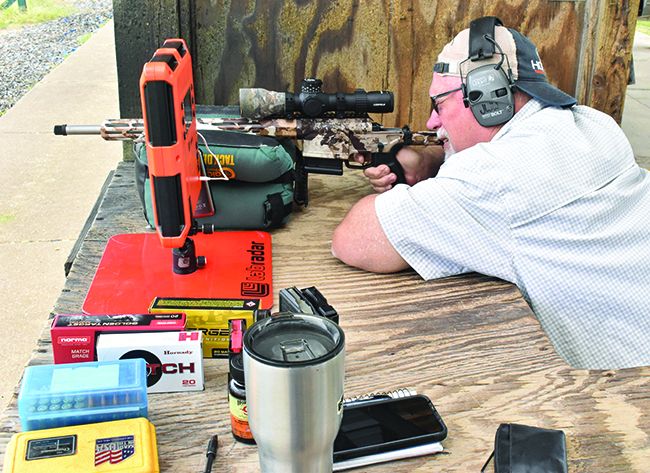The 6.5 Creedmoor cartridge has been one of the hottest rounds in the shooting world the last few years. With chambers and bullets designed for flat trajectory as well as accuracy, the 6.5 CM has proven to be a clear winner for hunters and Hornady, whose engineers designed the cartridge. Almost every rifle platform that comes in mid-caliber chamberings is offered in a 6.5 CM. We recently had the good fortune to test three new offerings chambered for this round:
First was a Savage 110 Elite Precision Impulse with a straight-pull action. It has an MDT chassis and the 26-inch heavy barrel of a PRS-style rifle. We wondered if the straight-pull action would as accurate or as fast as what we accustomed to using for long range shooting.
Next was a somewhat seasoned Tikka T3X CTR one of our test-team members loaned us. It is a bit heavy for what we would normally consider to be a hunting rifle, though it might be great as a beanfield rifle, but it is still a bit light to be a pure competition piece. We wondered if it might fill a spot as a “jack of all trades” choice.
Our final test rifle was the fairly new SIG Sauer Cross. Using a medium-length 18-inch barrel in a lightweight action, we needed to find out if it could shoot and still be easy to carry.
We realized that while we had the same testing process and the same requirements for each rifle, they were slightly different formats and, we thought, warranted slightly different optics. We mounted a Vortex Generation 3 Razor on the Savage. It weighs 45 ounces or thereabout, but then the Gen 2 Razor did as well. This scope is guaranteed forever, for whomever owns the scope and does not require a receipt. They will fix it or replace it — period. List price is $4K, but we found some for sale at Europtics.com for $3K. Note that most of the scopes owned by this team sport camo tape, which keeps us from beating up the objective bell as the optic is shoved in and out of barricades. We used the rock-solid Spuhr SP-4001 mount from MileHighShooting.com, where it runs a bit over $400.
The Tikka T3X CTR also sported a Vortex scope, in this case the Viper PST II 3-15×44. It uses almost the exact same reticle as its more expensive Gen 3 Razor brother. List price is right at $1200, though street price seems to be closer to $1000. Rings are by Warne.
We mounted a Leupold 5HD 3.6×18-44 on the SIG Cross using 35mm Leupold rings. This optic provides great clarity and magnification in a relatively small, light-weight package. Price for this high-quality scope runs in the $2000 range.
So equipped, the rifles had premium ammo fed into them. Our test rounds were Norma’s 143-grain Match bullets, along with Hornady 140-grain ELD-M cartridges, and Berger 144-grain Hybrid Target rounds. Three different ways of packaging the same cartridge in a bolt-action rifle, each of which absolutely had to be able to shoot well. How did they do? We had a blast finding out.
Gun Tests Grade: A- (OUR PICK)
$1840
Once almost exclusively the producers of semi-auto pistols from their factory in Switzerland, SIG Sauer USA now manufactures a full line of pistols and semi-auto rifles. What has been missing was a good bolt-action rifle. Their original entry into that field was the SSG 3000 in 1992, which was an interesting design with a quick-change barrel system. SIG Sauer USA announced the lightweight SIG Cross rifle in late 2019. Chamberings were in 6.5 CM, 308 Winchester, and the 277 Fury, the civilian version of the military’s 6.8×51 cartridge.
| Action Type | Bolt |
| Overall Length Folded | 27.3 in. |
| Overall Length | 37.5 in. |
| Barrel Length/Twist | 18.0 in., 1:8 |
| Overall Height w/o Scope Mount | 7.2 in. |
| Weight Unloaded | 6.9 lbs. |
| Weight Loaded | 7.4 lbs. |
| Sight Radius | NA |
| Action | FLC Cerakote-finished steel |
| Barrel | Brushed stainless steel |
| Magazine Capacity | 5 |
| Magazine Type | AICS-pattern detachable box |
| Stock | Aluminum |
| Stock Drop at Comb | -0.5 in. to +1.0 in. |
| Stock Drop at Heel | 0.0 in. |
| Stock Bedding | None |
| Stock Buttplate | Adjustable rubber |
| Stock Length of Pull | 12.75 in. to 14.75 in. |
| Receiver Scope-Base Pattern | 20-MOA Picatinny rail |
| Trigger Pull Weight | 1.9 lbs. |
| Safety | Ambi AR-15-style thumb selector |
| Warranty | Limited lifetime |
| Telephone | (603) 610-3000 |
| Website | SIGSauer.com |
| Made In | U.S. |
Our original intent was to source a sample of the most recent Cross offering — the longer-barreled version intended for the PRS crowd. When that proved impossible, and since we really wanted to check out their new rifle, we procured the 18-inch model of the original Cross. Rather than being designed for competition, the shorter model is designed for someone who needs a short, handy rifle still chambered in a substantial caliber. Realizing that compact, light long guns commonly leave something to be desired in the accuracy department, we thought our sample would at least let us examine the system. But we still had to know if it would shoot.
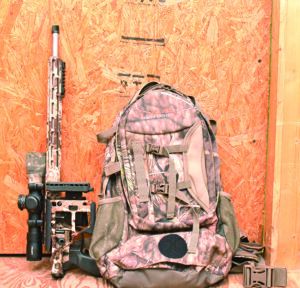
At first glance, the Cross rifle reminds us of an AR-15. The lines are about the same. The Cross sports an M-Lok fore end and an adjustable buttstock. It accepts an AR-style pistol grip on a good chassis. The last observation is, perhaps, the most misleading.
The design changes for the SIG Cross rifle start with the receiver. Rather than separate upper and lower halves, the Cross utilizes a monolithic piece of alloy — no splits, no take-down pins. As best we can tell, the 18-inch stainless-steel barrel stills attaches to the action using a steel extension. The octagonal handguard offers M-Lok slots at the 12, 3, 6, and 9 o’clock positions and mounts directly to the action, being secured by four Torx screws. The handguard is proprietary, and a standard AR-15-style version cannot be substituted. A mere 1.55 inches wide, the handguard is trim to the touch and carries well in the hand. The bottom flat, however, in only about 0.6 inch wide and tended to roll when set on a bag. Mounting a section of Picatinny rail and a good bipod from Atlas fixed any stability issues. The buttstock sports a reversible quick-detach cup, but there weren’t any on the fore end, so we added one of those as well. Weight gain was insignificant with these two additions, while the added utility was substantial.
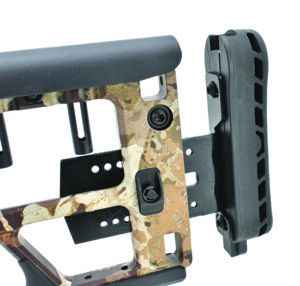
The SIG website claims that longer barrels will eventually be available that are designed for a user-friendly change. We could not find any available as of this writing. The existing barrel ends with 5⁄8×24 threads and comes with the SIG tapered cone mount and thread protector. It also includes an easily removed adapter for those using muzzle brakes or suppressors. SIG Sauer, to their credit, designed the barrel with a proper crown to protect the rifling.
The outline of the action looks almost like an AR-15 should. The magazine well is in the right place and is properly beveled. The ambidextrous thumb safety is where we would expect it to be, though we would recommend a small design change here. The safety button reminds us of one on a Sig MPX Pistol Caliber Carbine. While easy to operate on the PCC, the right-side switch has sharper edges and points than we like when we shoot with our thumbs in a strong-side placement.
The almost-straight trigger is a two-stage design, with a total required compression less than 2 pounds. Take-up is fairly short, but we could feel the trigger flex just a bit before the sear released. All said, it was very usable. A 20-moa Picatinny rail comes mounted. When we put the Leupold HD5 scope on top with its 35mm tube, we had more than 23 mils of elevation still available in the scope. That will take a 6.5 CM round a long way down range.
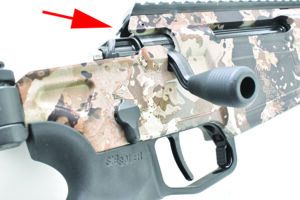
Another slight design change we would make is the ejection port. It is a bit small for our tastes. When we tried to catch our brass, the ejector was such that our empties would often wind up bouncing back inside the receiver and were then a bit difficult to fish out. If we ejected empty brass vigorously, everything worked perfectly.
The stock is of a design we easily see being mounted to some of our other carbines. Of a skeletonized structure, also made of aluminum, the stock offers adjustments for length of pull as well as butt pad height and cant. The cheek piece can also be adjusted for desired height and even helps the shooter find the right fit. First, press the button located on the right side of the stock and rotate the locking bar forward. The posts on which the cheek piece is mounted are spring-loaded. The shooter shoulders the rifle and places his head against the cheek piece, thus compressing the spring to the proper height. Rotate the locking bar back to the rear, and proper cheek weld has been established. The stock even folds forward to the right side, leaving a folded firearm less than 28 inches long. Just push a button at the hinge and lift up on the stock to fold forward. The same button must also be depressed to redeploy the stock to the open position.
When the stock folds forward, it captures and protects the bolt. We could almost forget this was a bolt-action rifle to that point. But bolt action it is, and SIG didn’t follow a traditional format with the bolt either. The body is a full-diameter piece measuring about 0.8 inch. It sports three locking lugs and uses a tapered rear face to the lugs. It looks a bit different, but it works. It also allows a shorter bolt throw than the two-lug variety. The body has longitudinal flutes, thus cutting a bit of weight and leaving a channel down which dirt may run. The large, replaceable bolt handle protrudes at about a 90-degree angle from the receiver when mounted. We found it very easy to locate and operate with speed. There is a single spring-loaded plunger ejector and a sliding plate extractor, both of which ran well when operated briskly. The bolt is released by pushed a button forward from its location just above the bolt. The stock, however, must be partially folded before the bolt can be removed.
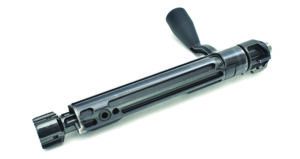
The five-round AISC-pattern magazine is released by pushing forward on a latch located inside the trigger guard. While not exactly convenient for using the trigger finger to release while the other hand reaches for the spare mag, we found the release sturdy and well-protected. The magazine arrived using a design we’d never seen. The body seems to be standard P-Mag five-round construction, but it uses an orange follower with a shelf and a ski jump, if you will. The “shelf” is a ledge about two-thirds the way forward on the follower. We can see how that would lift up the cartridge at the shoulder, changing the angle for proper insertion into the chamber. The “ski jump” is another ramp, with protective wings, that serves to cradle the tip of the bullet, ensuring correct positioning of it as well. Wondering if this was a requirement unique to this rifle, we tried some other magazines we had around the shop. The first was a 10-round P-Mag with the standard follower, and it didn’t do so well. The case rim would stay fairly low in the magazine and the bolt would frequently ride over the case, not feeding it into the chamber. Then we tried other metal AISC magazines, including Accurate Mag, MDT, and American Rifle Company units. Each of them lent the Cross rifle a 10-round capacity and worked perfectly. When we asked SIG Sauer about the follower, we were told that it is made by Magpul Industries for them to help with the single-feeding of cartridges. They work, but it does not seem they are available for individual sale.
Our Team Said: We’ve had good results with SIG Sauer firearms over the years, so we won’t say we were shocked by the performance of this lightweight rifle, but we were very pleased indeed. With the exception of feeding problems using a non-standard magazine, our SIG Cross functioned perfectly. Bolt throw is smooth and fast. The sub-2-pound trigger was easy to manipulate. Accuracy was outstanding. Slightly preferring the Hornady 140-grain ELD-M ammo, the Cross averaged right at half an inch for all three ammo types, with several groups in the 0.3-inch range. We can’t wait to test this rifle again once the quick-detach adapter comes in for our suppressor. So equipped, we think this could be a great rifle for maneuvering inside a deer stand or being carried in a backpack.
6.5 Creedmoor Range Data
All shooting was done at American Shooting Centers in Houston using multiple three-shot groups at 100 yards. All rifles were well-sandbagged in a Caldwell TackDriver Pro (Brownells.com 100-027-023, $49), further supported by a large rear bag, heavy from Tab Gear (TabGear.com, $34). Velocities were measured by LabRadar (MyLabRadar.com, $559).
| Norma Golden Target 143-grain Match | Savage Impulse Elite | SIG Sauer Cross | Tikka T3X CTR |
|---|---|---|---|
| Average Velocity | 2688 fps | 2430 fps | 2598 fps |
| Muzzle Energy | 2295 ft.-lbs. | 1876 ft.-lbs. | 2143 ft.-lbs. |
| Average Group | 0.75 in. | 0.57 in. | 0.44 in. |
| Best Group | 0.53 in. | 0.46 in. | 0.21 in. |
| Hornady Match 140-grain ELD-M | Savage Impulse Elite | SIG Sauer Cross | Tikka T3X CTR |
| Average Velocity | 2698 fps | 2542 fps | 2596 fps |
| Muzzle Energy | 2264 ft.-lbs. | 2009 ft.-lbs. | 2096 ft.-lbs. |
| Average Group | 0.61 in. | 0.46 in. | 0.41 in. |
| Best Group | 0.47 in. | 0.30 in. | 0.22 in. |
| Berger Long Range 144-grain Hybrid Target | Savage Impulse Elite | SIG Sauer Cross | Tikka T3X CTR |
| Average Velocity | 2798 fps | 2604 fps | 2734 fps |
| Muzzle Energy | 2504 ft.-lbs. | 2169 ft.-lbs. | 2391 ft.-lbs. |
| Average Group | 0.86 in. | 0.48 in. | 1.23 in. |
| Best Group | 0.65 in. | 0.33 in. | 1.07 in. |

























